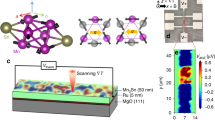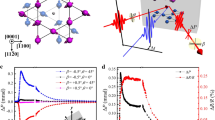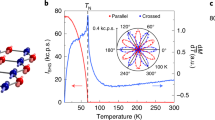Abstract
The magneto-optical Kerr effect (MOKE) has been intensively studied in a variety of ferro- and ferrimagnetic materials as a powerful probe for electronic and magnetic properties1,2,3 and for magneto-optical technologies4. The MOKE can be additionally useful for the investigation of the antiferromagnetic (AF) state, although thus far limited to insulators5,6,7,8,9. Here, we report the first observation of the MOKE in an AF metal. In particular, we find that the non-collinear AF metal Mn3Sn (ref. 10) exhibits a large zero-field Kerr rotation angle of 20 mdeg at room temperature, comparable to ferromagnetic metals. Our first-principles calculations clarify that ferroic ordering of magnetic octupoles11 produces a large MOKE even in its fully compensated AF state. This large MOKE further allows imaging of the magnetic octupole domains and their reversal. The observation of a large MOKE in an AF metal will open new avenues for the study of domain dynamics as well as spintronics using antiferromagnets12,13,14,15,16.
This is a preview of subscription content, access via your institution
Access options
Access Nature and 54 other Nature Portfolio journals
Get Nature+, our best-value online-access subscription
$29.99 / 30 days
cancel any time
Subscribe to this journal
Receive 12 print issues and online access
$209.00 per year
only $17.42 per issue
Buy this article
- Purchase on Springer Link
- Instant access to full article PDF
Prices may be subject to local taxes which are calculated during checkout




Similar content being viewed by others
References
Oppeneer, P. M. in Handbook of Magnetic Materials Vol. 13 (ed. Buschow, K. H. J.) 229–422 (Elsevier, Amsterdam, 2001).
Zvezdin, A. K. & Kotov, V. A. Modern Magnetooptics and Magnetooptical Materials (Institute of Physics, Bristol, 1997).
McCord, J. Progress in magnetic domain observation by advanced magneto-optical microscopy. J. Phys. D 48, 333001 (2015).
Mansuripur, M. The Physical Principles of Magneto-Optical Recording (Cambridge University, New York, 1995).
Kahn, F. J., Pershan, P. S. & Remeika, J. P. Ultraviolet magneto-optical properties of single-crystal orthoferrites, garnets, and other ferric oxide compounds. Phys. Rev. 186, 891–918 (1969).
Smolenskiĭ, G. A., Pisarev, R. V. & Siniĭ, I. G. Birefringence of light in magnetically ordered crystals. Sov. Phys. Usp. 18, 410–429 (1975).
Zenkov, A. V. et al. Anisotropry of the Faraday effect in the weak ferromagnet YFeO3. Zh. Eksp. Teor. Fiz. 96, 1397–1405 (1989).
Zubov, V. E., Krinchik, G. S., Seleznev, V. N. & Strugatskii, M. B. Surface magnetism of iron borate. Zh. Eksp. Teor. Fiz. 94, 290–300 (1988).
Eremenko, V. V., Kharchenko, N. F., Litvinenko, Y. G. & Naumenko, V. M. Magneto-Optics and Spectroscopy of Antiferromagnets (Springer, New York, 1992).
Nakatsuji, S., Kiyohara, N. & Higo, T. Large anomalous Hall effect in a non-collinear antiferromagnet at room temperature. Nature 527, 212–215 (2015).
Suzuki, M.-T., Koretsune, T., Ochi, M. & Arita, R. Cluster multipole theory for anomalous Hall effect in antiferromagnets. Phys. Rev. B 95, 094406 (2017).
MacDonald, A. H. & Tsoi, M. Antiferromagnetic metal spintronics. Phil. Trans. R. Soc. A 369, 3098–3114 (2011).
Gomonay, E. V. & Loktev, V. M. Spintronics of antiferromagnetic systems. Low Temp. Phys. 40, 17–35 (2014).
Jungwirth, T., Marti, X., Wadley, P. & Wunderlich, J. Antiferromagnetic spintronics. Nat. Nanotech. 5, 231–241 (2016).
Baltz, V. et al. Antiferromagnetism: the next flagship magnetic order for spintronics? Preprint at https://arxiv.org/abs/1606.04284v2 (2017).
Němec, P., Fiebig, M., Kampfrath, T. & Kimel, A. V. Antiferromagnetic opto-spintronics: part of a collection of reviews on antiferromagnetic spintronics. Preprint at https://arxiv.org/abs/1705.10600v2 (2017).
Argyres, P. N. Theory of the Faraday and Kerr effects in ferromagnetics. Phys. Rev. 97, 334–345 (1955).
Erskine, J. L. & Stern, E. A. Magneto-optic Kerr effect in Ni, Co, and Fe. Phys. Rev. Lett. 30, 1329–1332 (1973).
Kimel, A. V., Kirilyuk, A., Tsvetkov, A., Pisarev, R. V. & Rasing, T. Laser-induced ultrafast spin reorientation in the antiferromagnet TmFeO3. Nature 429, 850–853 (2004).
Kimel, A. V. et al. Optical excitation of antiferromagnetic resonance in TmFeO3. Phys. Rev. B 74, 060403(R) (2006).
Kalashnikova, A. M. et al. Impulsive excitation of coherent magnons and phonons by subpicosecond laser pulses in the weak ferromagnet FeBO3. Phys. Rev. B 78, 104301 (2008).
Saidl, V. et al. Optical determination of the Néel vector in a CuMnAs thin-film antiferromagnet. Nat. Photon. 11, 91–96 (2017).
Nagaosa, N., Sinova, J., Onoda, S., MacDonald, A. H. & Ong, N. P. Anomalous Hall effect. Rev. Mod. Phys. 82, 1539–1592 (2010).
Shindou, R. & Nagaosa, N. Orbital ferromagnetism and anomalous Hall effect in antiferromagnets on the distorted fcc lattice. Phys. Rev. Lett. 87, 116801 (2001).
Machida, Y., Nakatsuji, S., Onoda, S., Tayama, T. & Sakakibara, T. Time-reversal symmetry breaking and spontaneous Hall effect without magnetic dipole order. Nature 463, 210–213 (2010).
Chen, H., Niu, Q. & MacDonald, A. H. Anomalous Hall effect arising from noncollinear antiferromagnetism. Phys. Rev. Lett. 112, 017205 (2014).
Feng, W., Guo, G.-Y., Zhou, J., Yao, Y. & Niu, Q. Large magneto-optical Kerr effect in noncollinear antiferromagnets Mn3X (X = Rh, Ir, Pt). Phys. Rev. B 92, 144426 (2015).
Krén, E., Paitz, J., Zimmer, G. & Zsoldos, É. Study of the magnetic phase transformation in the Mn3Sn phase. Physica B+C 80, 226–230 (1975).
Tomiyoshi, S. & Yamaguchi, Y. Magnetic structure and weak ferromagnetism of Mn3Sn studied by polarized neutron diffraction. J. Phys. Soc. Jpn. 51, 2478–2486 (1982).
Nagamiya, T., Tomiyoshi, S. & Yamaguchi, Y. Triangular spin configuration and weak ferromagnetism of Mn3Sn and Mn3Ge. Solid State Commun. 42, 385–388 (1982).
Manyala, N. et al. Large anomalous Hall effect in a silicon-based magnetic semiconductor. Nat. Mater. 3, 255–262 (2004).
Solovyev, I. V. Magneto-optical effect in the weak ferromagnets LaMO3 (M= Cr, Mn, and Fe). Phys. Rev. B 55, 8060–8063 (1997).
Liu, J. & Balents, L. Anomalous Hall effect and topological defects in antiferromagnetic Weyl semimetals: Mn3Sn/Ge. Phys. Rev. Lett. 119, 087202 (2017).
Yang, H. et al. Topological Weyl semimetals in the chiral antiferromagnetic materials Mn3Ge and Mn3Sn. New J. Phys. 19, 015008 (2017).
Kargarian, M., Randeria, M. & Trivedi, N. Theory of Kerr and Faraday rotations and linear dichroism in topological Weyl semimetals. Sci. Rep. 5, 12683 (2015).
Badoz, J., Billardon, M., Canit, J. C. & Russel, M. F. Sensitive devices to determine the state and degree of polarization of a light beam using a birefringence modulator. J. Opt. 8, 373 (1977).
Patankar, S. et al. Resonant magneto-optic Kerr effect in the magnetic topological insulator Cr: (Sb x , Bi1−x)2Te3. Phys. Rev. B 92, 214440 (2015).
Perdew, J. P., Burke, K. & Ernzerhof, M. Generalized gradient approximation made simple. Phys. Rev. Lett. 77, 3865–3868 (1996).
Giannozzi, P. et al. QUANTUM ESPRESSO: a modular and open-source software project for quantum simulations of materials. J. Phys. Condens. Matter 21, 395502 (2009).
Vanderbilt, D. Soft self-consistent pseudopotentials in a generalized eigenvalue formalism. Phys. Rev. B 41, 7892–7895 (1990).
Mostofi, A. A. et al. Wannier90: a tool for obtaining maximally-localised Wannier functions. Comput. Phys. Commun. 178, 685–699 (2008).
Zhu, L. J., Pan, D., Nie, S. H., Lu, J. & Zhao, J. H. Tailoring magnetism of multifunctional Mn x Ga films with giant perpendicular anisotropy. Appl. Phys. Lett. 102, 132403 (2013).
Zhu, L. J., Brandt, L., Zhao, J. H. & Woltersdorf, G. Composition-tuned magneto-optical Kerr effect in L10-MnxGa films with giant perpendicular anisotropy. J. Phys. D 49, 245001 (2016).
Krishnan, K. M. Ferromagnetic δ-Mn1−xGax thin films with perpendicular anisotropy. Appl. Phys. Lett. 61, 2365–2367 (1992).
Kato, T., Kikuzawa, H., Iwata, S., Tsunashima, S. & Uchiyama, S. Magneto-optical effect in MnPt3 alloy films. J. Magn. Magn. Mater. 140, 713–714 (1995).
Di, G.-Q., Oikawa, S., Iwata, S., Tsunashima, S. & Uchiyama, S. Kerr rotation of quenched high-temperature-phase MnBi Film. Jpn J. Appl. Phys. 33, L783 (1994).
Yamamoto, S. & Fujii, T. Magnetic and magneto-optical properties of Sn-substituted Mn2Sb films. IEEE Trans. J. Magn. Jpn 6, 862–868 (1991).
Buschow, K. H. J., van Engen, P. G. & Jongebreur, R. Magneto-optical properties of metallic ferromagnetic materials. J. Magn. Magn. Mater. 38, 1–22 (1983).
Ohyama, R., Koyanagi, T. & Matsubara, K. Magneto-optical Kerr effect of rf-sputtered PtMnSb thin films. J. Appl. Phys. 61, 2347–2352 (1987).
Mitani, S. et al. Perpendicular magnetic anisotropy and magneto-optical Kerr rotation in FePt(001) monoatomic multilayers. J. Magn. Magn. Mater. 148, 163–164 (1995).
Zhang, X., Schoenes, J. & Wachter, P. Kerr-effect and dielectric tensor elements of magnetite (Fe3O4) between 0.5 and 4.3 eV. Solid State Commun. 39, 189–192 (1981).
Gilleo, M. A. in Handbook of Ferromagnetic Materials Vol. 2 (ed. Wohlfarth, E. P.) 1–53 (North-Holland, Amsterdam, 1980).
Kahn, F. J., Pershan, P. S. & Remeika, J. P. Ultraviolet magneto-optical properties of single-crystal ferrimagnetic ferric oxide compounds. J. Appl. Phys. 40, 1508–1510 (1969).
Visnovsky, S. et al. Magnetooptical polar Kerr effect in ferrimagnetic garnets and spinels. IEEE. Trans. Magn. 17, 3205–3210 (1981).
Nielsen, J. W. Properties and preparation of magnetic materials for bubble domains. Met. Trans. 2, 625–633 (1971).
Treves, D. Studies on orthoferrites at the Weizmann institute of science. J. Appl. Phys. 36, 1033–1039 (1965).
Acknowledgements
The authors thank Y. Otani, M. Kimata, L. Balents, H. Chen, H. Ishizuka, O. Tchernyshyov and C. Broholm for discussions. This work is partially supported by CREST(JPMJCR15Q5), Japan Science and Technology Agency, by Grants-in-Aids for Scientific Research on Innovative Areas (15H05882 and 15H05883) from the Ministry of Education, Culture, Sports, Science, and Technology of Japan, and by Grants-in-Aid for Scientific Research (16H02209) and the Program for Advancing Strategic International Networks to Accelerate the Circulation of Talented Researchers (no. R2604) from the Japanese Society for the Promotion of Science (JSPS). Kerr spectroscopy was supported by the US Department of Energy, Office of Science, Office of Basic Energy Sciences, Materials Sciences and Engineering Division under contract no. DEAC02-05CH11231 within the Spin Physics programme (KC2206). L.W. is supported by the Gordon and Betty Moore Foundation’s EPiQS Initiative through grant GBMF4537 to J.O. at UC Berkeley. Y.L. was supported in part by SHINES (grant SC0012670), an Energy Frontier Research Center of the US Department of Energy, and grant DE-SC0009390. This research is funded in part by a QuantEmX grant from ICAM and the Gordon and Betty Moore Foundation through grant GBMF5305. The work of T.H., H.M. and S.N. at IQM was partially supported by the US Department of Energy, office of Basic Energy Sciences, Division of Material Sciences and Engineering under grant DE-FG02-08ER46544. T.H., H.M. and S.N. greatly appreciate the hospitality of the Department of Physics and Astronomy of Johns Hopkins University, where part of this work was conducted. The use of the facilities of the Materials Design and Characterization Laboratory at the Institute for Solid State Physics, The University of Tokyo, is acknowledged.
Author information
Authors and Affiliations
Contributions
S.N. conceived the project. S.N., R.D.S., J.O. and C.L.C. planned the experiments. M.I. synthesized the single-crystalline samples. T.H., S.N. and M.I. performed magnetization and Hall effect measurements. T.H. and H.M. prepared the samples for magneto-optical experiments. O.M.J.v.E. and D.B.G. performed the MOKE loop experiment. L.W., D.R. and S.P. performed the MOKE spectroscopy experiment. T.H., H.M., D.B.G. and Y.P.K. performed the MOKE imaging experiment. Y.P.K. and Y.L. carried out the image processing. R.A. planned the theoretical calculations, and T.K., M.-T.S. and R.A. performed the first-principles calculations. T.H., D.B.G., L.W., O.M.J.v.E., C.L.C., R.A., R.D.S., J.O. and S.N. discussed the results, and T.H., D.B.G., L.W., T.K., R.A., J.O. and S.N. wrote the manuscript and prepared figures. All authors commented on the manuscript.
Corresponding author
Ethics declarations
Competing interests
The authors declare no competing financial interests.
Additional information
Publisher’s note: Springer Nature remains neutral with regard to jurisdictional claims in published maps and institutional affiliations.
Rights and permissions
About this article
Cite this article
Higo, T., Man, H., Gopman, D.B. et al. Large magneto-optical Kerr effect and imaging of magnetic octupole domains in an antiferromagnetic metal. Nature Photon 12, 73–78 (2018). https://doi.org/10.1038/s41566-017-0086-z
Received:
Accepted:
Published:
Issue Date:
DOI: https://doi.org/10.1038/s41566-017-0086-z
This article is cited by
-
Altermagnetism with non-collinear spins
npj Quantum Materials (2024)
-
Topological Kerr effects in two-dimensional magnets with broken inversion symmetry
Nature Physics (2024)
-
Field-linear anomalous Hall effect and Berry curvature induced by spin chirality in the kagome antiferromagnet Mn3Sn
Nature Communications (2023)
-
Octupole-driven magnetoresistance in an antiferromagnetic tunnel junction
Nature (2023)
-
Spontaneous topological Hall effect induced by non-coplanar antiferromagnetic order in intercalated van der Waals materials
Nature Physics (2023)



